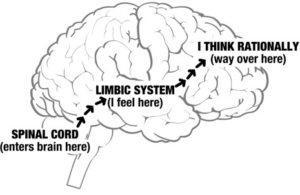
10 BEST TIME-MANAGEMENT PRACTICES:
- Have a solid morning routine
- Get out of the email jail (texting and messaging too)
- Block time
- Create a bullet-proof daily “To Do” system
- Learn a prioritization matrix for that “To Do” system
- Have the courage to say “no” to meetings, assignments and interruptions
- Single-tasking instead of multi-tasking
- Don’t get derailed by your Lizard Brain
- Take frequent and systematic breaks
- Don’t be afraid to delegate
We looked at numbers 1 through 6 in previous articles. Today, I will cover best practices 7 and 8
TIME-MANAGEMENT PRACTICE 7: SINGLE-TASKING INSTEAD OF MULTI-TASKING
Have you ever seen those old ads for cigarettes? There’s one that says “More doctors smoke Camels than any other cigarette!” Can you imagine! I feel the same way about multi-tasking. It used to be seen as a professional strength to be able to multi-task. Now that advances in technology bombard us with constant information and opportunities to get interrupted, multi-tasking is what we do all day long now and it’s given us some really bad habits.
A study at Stanford University in 2009 showed that “heavy media multi-taskers are more susceptible to interference from irrelevant environmental stimuli and from irrelevant representations in memory. This led to the surprising result that heavy media multi-taskers performed worse on a test of task-switching ability, likely due to reduced ability to filter out interference from the irrelevant task set.” “The low multitaskers did great,” Ophir said. “The high multitaskers were doing worse and worse the further they went along because they kept seeing more letters and had difficulty keeping them sorted in their brains.”
Multitasking depletes your performance and efficiency because your brain can only focus on one thing at a time. When you try to do several things at once, your brain lacks the capacity to perform both tasks successfully. So, while you may be able to switch between many things simultaneously, you are more likely to do them poorly, thus harming your performance at all of them.
It’s also a big way to turn people off and ruin your rapport with colleagues and clients alike. For example, let’s say that you’re meeting with someone and they keep glancing down at their phone, or going a step beyond that and sending messages while you try to carry on a dialogue with them. This practice says that they’re not particularly present with you or interested in whatever might come out of this meeting.
But let’s take that same dynamic and apply it to conference calls. Once you’re in a virtual world, the temptation to multi-task is palpable. It’s so easy to find yourself suddenly answering email or doing a google search instead of participating in a conference call. And we seem to find this behavior more acceptable, but the fact is that the dynamic is the same. This will impact your ability to be present and practice good listening with colleagues and clients.
In fact, I am willing to bet that some of you have even multitasked while reading this article. Did you?
Bottom Line: Single tasking means better quality.
TIME-MANAGEMENT PRACTICE 8: DON’T GET DERAILED BY THE LIZARD BRAIN
Have you ever sent an email out to a large group when you are upset and tired, and regretted it the next day? Have you ever spent time dwelling on something someone said to you that upset you? This is your lizard brain at work.
Now, in case this is your first exposure to the concept of the lizard brain, here’s a brief overview. There is a part of your brain that is responsible for keeping you alive. It is called the limbic system or amygdala. This is about all a lizard has for brain function, because it’s all it needs. It is in charge of fight, flight, feeding, fear, freezing-up, and reproduction. Humans, on the other hand, have highly developed brains.
Before your brain can process something rationally and logically in the frontal cortex (the thinking part of the brain that we humans have), every sense first goes through the limbic system. The diagram below from the first chapter of Emotional Intelligence 2.0, illustrates this very simply.

The limbic system/lizard brain can produce a string of feelings that may prevent you from acting rationally. In his book, Emotional Intelligence, Daniel Goleman coined the phrase“Amygdala hijack” to describe this dynamic. That is, you are more susceptible to being hijacked when you are tired and hungry, for example. This is what leads to the late night nasty email or yelling at the kids like a maniac when you a running on limited sleep. We like to call it lizard brain as it’s easier to remember. You may have noticed that Rewire’s corporate logo has a lizard in it. Now you know why!
“But how does the lizard brain relate to time-management?”
That’s an excellent question. And Goleman is again helpful as we think about this: “When Mike Tyson bit Evander Holyfield’s ear, it was a very bad business decision – it cost him $3 million. It was an amygdala hijack.” That is, when our actions get hijacked by our lizard brains, there is a cost. In Mr. Tyson’s case, it was money. For you and me, it may or may not be money, but it will definitely cost us time. Think about the example I gave of the emotionally-charged and explosive email:
- How much time will you lose worrying about the fallout from that email?
- How much time will you have to spend trying to mend fences after that email does its damage?
- What if it ultimately leads to you losing your job? How much time does finding and securing a new job take?**
Since the lizard brain can hijack our thinking in some very unproductive ways, understanding and learning how to deal with your lizard brain is extremely valuable as a time-management best practice. Now, I’ll be the first to admit that this is not easy, but I’ve seen dividends repeatedly in my own business and that of my clients as they’ve undertaken to work on stilling (or quieting) the lizard brain. If you’d like extra support on this, I’d highly recommend reading through our articles on the lizard brain and mindfulness here on The Wireboard. We're also happy to dialogue with any readers about how to free up time by quieting the lizard brain. Just contact us or drop a comment below.
We’ve now gone through eight of my Ten Best Time-Management Practices. I’ll have the last two in my next article. In the meantime, have you implemented any from the list so far? Have you noticed any changes in productivity as a result? Let me know in the comments section.
____________
** That last one might sound like overkill, but I’ve seen people lose jobs over actions they’ve taken because their lizard brain has hijacked their thinking and pushed them into blow-ups that they can’t recover from at their current job.




